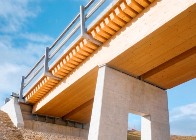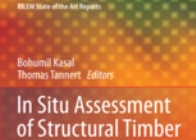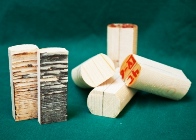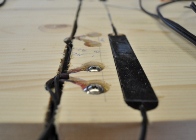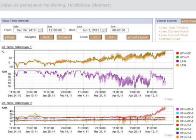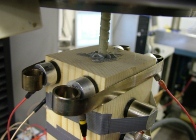Monitoring of UBC Tall Wood Building
In this project, three aspects that posed specific challenges to UBC Tall Wood Building are being monitored: 1) Moisture content of CLT panels; 2) Horizontal vibrations; and 3) Vertical settlement including elastic shortening, moisture related shrinkage and creep. The moisture content of CLT floor panels is being monitored from the moment of fabrication over the time of storage, transport, installation, building completion and use. The accelerations of the building, in both building directions, at different levels, is being recorded by accelerometers to monitor the serviceability performance during regular and extreme wind events and potentially, the ultimate limit state performance during an earthquake. Differential movement between parts of a building is an important consideration due to the cumulative effect of vertical settlement and is being recorded for two columns.
Long-term moisture monitoring of Block-laminated timber bridges
This project deals with the long term moisture measurement inside block-laminated timber elements of several traffic bridges. Presently there is little information available on the long-term moisture behaviour and the resulting dimensional changes. Two case studies provide data on the changes of MC in different cross sections of block-laminated elements. Different MC’s are observed depending on the cross sectional depth and height as well as position along the beam. If not restricted by the large cross section, the observed MC changes would lead to significant dimensional changes and differences in such dimensional changes within the cross section.
In-situ assessment of structural timber
Related to the structural assessment of timber, I led two projects dealing with non-destructive techniques and the prevention of structural failures at the Bern University of Applied Sciences. I was actively involved in European COST Action E55 “Reliability of Timber Structures” and successfully proposed the new COST Action FP1101 ”Assessment, Retrofitting and Monitoring of Timber Structures”. I am further secretary of the RILEM committee 215 “In-situ Assessment of Structural Timber” and co-edited a Springer book with the same title.
Assessment of Glulam Structures with Shear Core Samples
For the assessment of existing glued-laminated beams, often the standard for shear test of glue-lines (EN 392) is applied. In a case study, from beams of a decommissioned skating rink, 20 bending and 128 shear tests on representative large scale, and 608 shear tests on core samples were conducted. The results demonstrate that core samples can be used to derive the local shear strength of glue-lines; however, due to the low correlation with the shear and bending strength, the practice of assessing glued laminated timber based on the glue-line strength of core samples has to be re-evaluated.
Fibre-optic strain measurements in block-laminated timber
In a laboratory project, a laminated timber block at structural scale subjected to controlled and monitored variable climatic conditions was instrumented with fiber-optic strain sensors and moisture and temperature sensors. The following questions were addresses: i) which equilibrium moisture content is reached after what period of time, ii) what are the differences in moisture content changes along and across the elements, and iii) which dimensional changes are caused by these changes. Fist results clearly indicate that assumptions on moisture induced stresses based on the extrapolation of available data from smaller elements are not adequate.
Remote-health monitoring of Timber Bridge
This pilot project deals with the remote moisture monitoring of a timber traffic bridge. Until recently, timber bridge inspections were carried out exclusively through on-site visits. An automated remote monitoring system provides a more efficient way to enable a sound structural assessment with continuous records of almost any required parameter. In the case study, a data recording system was installed and all data is remotely transferred to a server. A web interface provides continuous information on the structure’s condition, and allows identifying gradual changes over a period of time.
Acoustic emissions monitoring during destructive testing
Damage initiation and accumulation of several types of timber joints were investigated with Acoustic Emission (AE) equipment. In order to evaluate the Felicity-ratio, the loads were applied in sequential steps of loading-holding / loading-unloading under displacement control. AE activity, AE intensity and AE source location as well as the AE Felicity-ratio were analyzed and discussed for selected joints with respect to their potential for developing a monitoring method for structural applications. While the experiments reported indicate the potential of AE analysis for this purpose, the practical realization will require further, extensive and detailed investigation.


